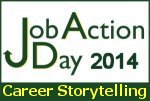 Storytelling – does it make you think of sitting on a carpet decorated with pictures depicting the alphabet while trying to stay away from the kid who could never keep his feet to himself? Okay, maybe that was really “story time.† Telling and hearing stories isn’t something the average adult considers part of his or her professional life.
Storytelling – does it make you think of sitting on a carpet decorated with pictures depicting the alphabet while trying to stay away from the kid who could never keep his feet to himself? Okay, maybe that was really “story time.† Telling and hearing stories isn’t something the average adult considers part of his or her professional life.
This post is in honor of Job Action Day 2014, with the theme of “Career Storytelling.” Job Action Day is a day for all job-seekers and workers to take stock of their situations and make plans and/or take action steps to improve their careers. QuintCareers.com spearheads and runs this event every year, and I’m delighted to contribute and to suggest you visit other post about the topic. Follow #JAD14 on Twitter for information.
It may come as a surprise that marketing your skills for a job is all about storytelling. Jobseekers need to be able to tell their stories in varied ways, using a myriad of tools.
Before you bring out your quill pen – or, more likely, your laptop or tablet – to start authoring your story, your first job is to know what it is you want to tell. It sounds obvious, doesn’t it? Unfortunately, it’s not so obvious in practice for many people. If you don’t have a very clear idea of what you do well – and why people should want to hire you to do it for them – you will be at a big disadvantage. It’s tough to get on the right path until you know your destination.
Before you start trying to integrate your “story†into your job search strategies, first focus on your skills. So many job seekers don’t take the time to really identify what they have to offer in the way of skills. This is a real problem when it comes to the self-marketing, self-selling and interviewing aspects of the job search. If you don’t know what you have to offer, who does?
There are many ways to approach figuring out your skills. There is a basic one that I advise my clients to consider: review job descriptions of positions that interest you. Highlight all of the skills required that you’ve EVER used or could remotely be related to you. Then, go back and check off the skills that really resonate and feel like “you.â€Â This is a basic, not time consuming and free way to get you thinking about your skills.
Describe your story as it relates to your skills. When you think about your job search story, hone in on exactly why and how you are a good fit for the opportunity of interest.
Tell the relevant story at every stage of your search:
Networking: Use your LinkedIn profile to showcase your passion for your work and why you’re good at what you do. Consider a less formal approach to help connect with readers; speak in the first person and detail why readers should want to know more about you.
In all social media, keep in mind that you are proving you have the answers to the problems hiring managers are trying to solve. Indicate how you help in your headlines – no matter how short. Even a 160-character Twitter bio can tell a brief story.
At in-person events, be prepared to introduce yourself. Don’t prepare a 2-minute speech – be able to say who you are and what you do in 15 seconds or less. You could use a slightly longer version of your Twitter bio or LinkedIn headline to get to the heart of what you want people to know.
In your resume: This is your opportunity to draw a clear and distinct line between what you offer and what the employer wants in a candidate. Focus extensively on the job description of interest and incorporate keywords that match the employer’s needs when explaining via your headlines and job descriptions why you are a good match.
Get my free white paper:Â 5 Mistakes Preventing You From Landing a Job This WeekÂ
In the interview: For years, coaches have advised using a “CAR†or “PAR†approach to interview storytelling. (This also works in resumes.) CAR is “challenge, action, results.†PAR is “problem, action results.†The main point is that you need to be able to tell stories explaining challenges or problems you faced and to describe how you handled them. The best part of keeping these acronyms in mind is they help remind you to incorporate the “results†piece in your story.
Once you solidify your story, you’ll be well on your way to job search success!